

Editor: Jaap Horst
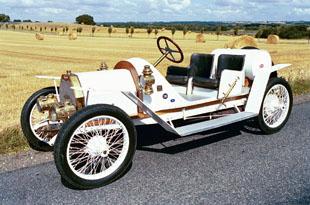
This is the fabulous story of the rebuilding, indeed rebirth, of the third oldest Bugatti in the world! This wonderful old racing car has survived - thanks to a stubborn amateur mechanic - the attentions of fanatic English vintage car buyers, many years spent in a heap of rusty scrap metal and after it's restoration, a serious crash during a race in Denmark. This old jewel is still owned by the family of the aforementioned "stubborn mechanic", Dennis Hebsgaard and now, the family have reluctantly decided to put the car up for auction, at Christies in Paris, on 14th. February 2004.
In 1960 Dennis had only recently returned to Copenhagen after three years work in Canada, his head full of ideas. But despite the fact that he had shown no special interest in vintage cars before, his brother in law, Preben Nielsen was somewhat surprised by Dennis' seeming obsession with one old car in particular. Ever since he was a lad in Thy, Dennis had been fascinated by the wondrous old machine that a local mechanic, Jens Nielsen (who, by the way, is no relation of his brother in law!) had raced during his youth. The Bugatti no less!
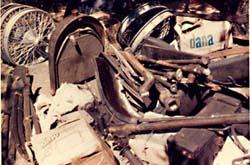 During a family visit to Thy,
Dennis looked in on his old friend Jens and was met by a very sad sight.
Under a heap of rusty old motorcycle and car parts, he espied the famous
oval enamel radiator badge - Bugatti. Worse still, the rest of the car lay
in pieces, spread in the dirt.
During a family visit to Thy,
Dennis looked in on his old friend Jens and was met by a very sad sight.
Under a heap of rusty old motorcycle and car parts, he espied the famous
oval enamel radiator badge - Bugatti. Worse still, the rest of the car lay
in pieces, spread in the dirt.
Jens Nielsen was by now an elderly gentleman but he still wasn't interested in selling. He still had plans for restoring the car himself and Dennis had to drive back to Copenhagen with only his dreams in tow. But Lady Luck smiled on him a few months later. Whilst reading the local paper, Dennis' mother Visse happened to notice an advertisement: "On demand of the heirs, the estate and chattels of the late Jens Nielsen will be sold at auction in Thy, on Tuesday 14th. At 2 o'clock". Amongst the effects were thirty five steel drills, six motorcycles, a grindstone, some accumulators and a 1911 Bugatti - without coachwork. Remembering her son's passionate interest, Visse Hebsgaard, rang her son in Copenhagen. He cajoled her into going to the auction on his behalf and gave her the parting broadside of, "Don't come home without that car!"
The auction began at 2 o'clock sharp under the auspices of a local solicitor, Johan Jacobsen but many of the assembled crowd didn't realise the fact, before the auctioneer's hammer had fallen, and the Bugatti had been sold to Dennis' mother, Visse Hebsgaard for just 2,800 kr! Several of interested parties (amongst others, a lawyer from Denmark's Technical Museum and representatives from the British Bugatti Club) were so taken aback that they complained bitterly to the auctioneer that they hadn't known that the auction had started, before it was all over. They hadn't understood the auctioneer's strong Thy accent, or the local custom of "nodding" bids. Another battle lost by city slickers to country bumpkins. Numerous articles in the Danish press seem to bare out this view of things: "Auctioneer in Thy gives city boys runaround". "Expert's wasted trip". "Able to buy Bugatti because she understood local accent". Despite angry protests, the auctioneer, Johan Jacobsen scoffed at the idea of any form of unfairness during proceedings. "The auction was announced in the paper and proper notice was therefore given. I can't be expected to greet everybody personally and announce my arrival", he said to a journalist from one of the national papers reporting the story and added that he didn't understand what all the fuss was about, "Just for an old Bugatti!"
But a fuss there most certainly was. Before Visse Hebsgaard had even left the auction, she had been offered twenty times what she had just paid for it! And considering what a canny business woman Visse was, it was a wonder that no deal was struck, though she was tempted. She still had Dennis' words ringing in her ear, "Don't come home without that car!"
In the November of 1960, Dennis collected his ruin of a Bugatti in Hurup, in Thy and here started the realisation of a dream - a dream that consumed all of the family's leisure time for the next 17 years. Dennis was head of department in a substantial civil engineering firm and as soon as he got home from work every day, he rolled up his sleeves, tucked his tie inside his shirt and threw himself into the restoration of the Bugatti. He never even used to take the time to change into overalls and the perfectionist that he always was, he never got grime on his shirt. The Bugatti was his only interest. Everything revolved around the old car. He offered thousands of hours on the restoral and study of Bugatti's classic marque. His three boys were almost always there to lend a hand and as his eldest son, Thomas, remembers, "Even our holidays revolved around that car. While our mates were out swimming or relaxing, we were always hurrying around from one technical museum to the next, learning about Mr. Bugatti and his cars. Small wonder that two out of the three of us are now mechanics by trade".
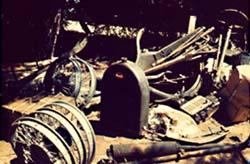 When Dennis started work on the car, there was only a chassis,
a radiator and ten cardboard boxes full of assorted "junk". As an
electronics engineer, he was certainly a novice at classic car restoration
and he knew precious little about motor cars in general and Bugattis in
particular but what he lacked in theoretical knowledge and experience, he
made up for in practical skills and a determination that would not be
denied. For example when he put the car back together for the first time,
he didn't clean any of the parts. The leftover grime on all the bits and
pieces gave him a basic idea of what went where.
When Dennis started work on the car, there was only a chassis,
a radiator and ten cardboard boxes full of assorted "junk". As an
electronics engineer, he was certainly a novice at classic car restoration
and he knew precious little about motor cars in general and Bugattis in
particular but what he lacked in theoretical knowledge and experience, he
made up for in practical skills and a determination that would not be
denied. For example when he put the car back together for the first time,
he didn't clean any of the parts. The leftover grime on all the bits and
pieces gave him a basic idea of what went where.
Six times during the coming years, Dennis dropped his wife and sons off with his wife's mother in Århus and with his brother-in-law, Preben, in tow, drove to the late Jens Nielsen's farmyard in Hurup, to sort through the three tons of rusty bits and bobs, nuts and bolts and various who-knows-what, trying to solve the gigantic jig-saw puzzle that was to become his beloved Bugatti. And each time, they found more and more missing parts that Dennis and his boys doggedly tinkered with until they fit.
Hundreds of parts hung from piano wire from the ceiling of Dennis' basement until finally, there were only two yet to be found - a small piece of one of the pedals and a spark plug. Give up? Never! Not Dennis. So once again, he parked the kids in Århus, he and Preben took the long drive to Hurup and they ploughed slowly through the mountain of rusty junk one last time, piece by piece, under much protest from his hunting partner. In the cold and wet Danish winter, they turned every last piece over in their hands. Searching, searching. Dennis wouldn't be denied. It was all or nothing. He was determined to have the WHOLE car!
The part of the pedal turned up almost at once but the spark plug was nowhere to be found. Wet through, cold, tired and very disappointed, they clambered into their car and set off for Århus. Before long they had to stop to honour the call of nature in the lea of a mound of turnips. A old tractor chugged past and Dennis did a double take. "There!" he shouted, buttoning his overalls. "That's it!" He and a puzzled Preben jumped in the car and quickly caught up with the ancient tractor. And there was no doubt. The tractor's hexagonal spark plug was from a Bugatti! Yes, the farmer said, he'd bought the plug from old Jens Nielsen. No, he said, he wouldn't mind in the least, swapping it for a brand new one. So in the end, Dennis found the last piece of the jig-saw puzzle and the rebirth of a noble 1911 Bugatti racing car could begin in earnest.
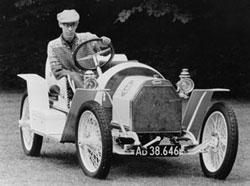 In all, it took Dennis six
years to complete the reconstruction and restoration of the car. First he
assembled everything - every part was registered, numbered and described
in detail. Then the whole thing was taken apart, cleaned, polished, oiled,
greased, painted and assembled once more. And at long last, on a certain
Saturday in June 1966, it was ready. At 3.51p.m. Dennis swung the crank
and for the first time in 35 years, the 3rd. oldest Bugatti in the world,
fired up…….. and low and behold, she purred like a kitten!
In all, it took Dennis six
years to complete the reconstruction and restoration of the car. First he
assembled everything - every part was registered, numbered and described
in detail. Then the whole thing was taken apart, cleaned, polished, oiled,
greased, painted and assembled once more. And at long last, on a certain
Saturday in June 1966, it was ready. At 3.51p.m. Dennis swung the crank
and for the first time in 35 years, the 3rd. oldest Bugatti in the world,
fired up…….. and low and behold, she purred like a kitten!
In 1967 the Hebsgaard family - and their beloved Bugatti - moved to Skanderborg and during the next 11 years, they ferried one trophy after another home to their, by now overfilled, mantle piece. It seemed as if they won some prize or other at almost every race meeting they entered. And then, on 23rd. of June 1977 at Jyllandsringen, a racetrack in Jutland, Dennis' life with his racing Bugatti, the car that had been his focus for so many years, changed dramatically and for ever.
Some of the most splendid and spectacular classic vintage cars in Europe had convened for a weekend of racing nostalgia. The weather was fine and a large and enthusiastic crowd were enjoying the sight and sound of all the thoroughbreds there assembled. The meeting was being covered by national TV and Dennis had just completed a few laps with a television reporter. The TV crew wanted a shot of Dennis and his wife, Jytte, doing a lap of honour. Tragically, things went badly wrong. The suspension on one of the front wheels collapsed in the middle of a corner and the old car rolled. Jytte Hebsgaard was thrown clear but Dennis took the roll with the car. Both survived, Jytte with only minor cut and bruises but Dennis was hurt so badly that the left side of his face was permanently paralysed.
Dennis was never himself again after the accident. He still loved his Bugatti and worked for hundreds of hours on restoring her to her former glory. He even sacrificed some of the many trophies he'd won over the years, melting them down to repair the original brass headlamps that were smashed when the car crashed. But Dennis' racing days with his Bugatti were over. Indeed he almost never drove her again.
Dennis Hebsgaard died in 1990 and his three sons inherited the car jointly. Now it is they, like their father before them, who drive and maintain the Bugatti, while their children play in the workshop.
First published in: www.1911-bugatti.dk The website includes a video!
Bugatti type 15 year 1912
Of relatively lightweight proportions, even in these early days Bugatti favoured the use of the finest materials and combined with his exceptional design skills enabled these cars to provide performance out of character with their size. The cars received very favourable press response, not least by W.F. Bradley in The Motor in November 1910, where he comments 'as a runabout the Bugatti seems ideal, for on open roads, it is as fast as any of the larger mounts, and in traffic it is quicker because of its handiness.' 'The makers guarantee that the little Bugatti can maintain 60 miles an hour, the claims seems to be well-founded.'
The 8 valve cars were immediately campaigned in various events, the results of which were proclaimed proudly in sales catalogues, earliest successes being first places in the meeting at La Sarthe on June 4/5th 1911.
The chassis sequence began with number 361, and was consecutive making this the 86th car built. There are fewer than 20 surviving examples of the model, the only known earlier extant being: chassis 365 which resides in the Science and Technical Museum in Prague; chassis 366 which is in National Motor Museum Beaulieu; 424 is thought to be in Australia; and 442 which resides in France.
1912-1919 - ownership history is not known, however research by the current owners have traced Danish origins for the car back to 1919.
The car is then known to have passed through the hands of three Danish custodians Peter Sand of Herning, Victor Hanke of Vestervig and Jens Nielsen of Hurup. Nielsen is thought to have purchased the car in 1935.
By the late 1950s the car laid in dismantled state, Nielsen having intended to restore the car but never completing it. The current owner's father pursued Nielsen and tried to buy the car on a number of occasions, but was always refused. However, on his death in 1960 a public auction presented this opportunity. Local Danish folklore records that the auction was held in a particularly difficult regional dialect `thybosk' which confused all the potential International and institutional buyers, and before they were aware that the auction had begun the auctioneer had already sold the car to the cogniscent local interested party!
On acquisition, restoration of the car was initiated. Careful assembly of all of the parts made it clear that there were some missing, and provoked many return journeys to Nielsen's house. The tales of these visits make interesting reading, amazingly one period spark plug was retrieved from a farmer's tractor, the farmer having purchased it from Nielsen many years before!
By June 1966, the car was back on the road and has remained in active use ever since.
The sparse bodywork has been constructed in period lightweight style with rear bolster fuel tank behind which the spare wheel is mounted. The uncluttered dashboard proudly wears its original chassis plate, beside which is a visible drip feed oiler and modern pressure gauge.
Mechanically the car is in usable order and on recent inspection promptly jumped into life. On a brief test run it quickly re-assured this writer of its very capable performance as well as being remarkably comfortable to drive.
Addition: the car was on auction by Christie´s, February 14, 2004
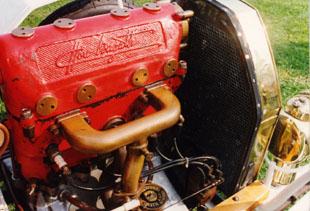
The Sixth earliest surviving Bugatti
Rupert Banner, Christies UK
Chassis No. 446
Engine No. 88
Four cylinder, overhead valve, 1,327cc, 15bhp at 2,500rpm;
Four speed manual;
Front, semi-elliptic leaf spring, rear, semi-elliptic leaf spring;
Two wheel rear drum.
Right hand drive
Two seater sports. White with black upholstery.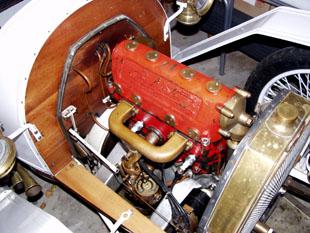
Model history
Introduced in 1910, Bugatti's first production car is often retrospectively referred to as the Type 13, though contemporary literature confirms five variants of 8 valve four cylinder cars in this period. The distinguishing feature for 1912 cars was the wheel base length, the Type 13 being 2 meters, while two other models a 2.4 meter Type 15 and 2.55 meter Type 17 were also listed. The latter two cars carried twin rear springs and ran on larger 700 by 85mm tyres. It was not until the following year that the reverse quarter-elliptic springs so synonymous with the marque appeared on the revised Type 15 and 17 models.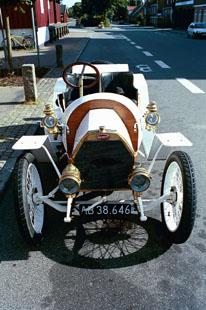 Production of these Bugattis ran from 1910 to the outbreak of war in 1914 by which time over 300 cars had been built, it continued after the war for a year from 1919, bringing total unit numbers to 435.
Production of these Bugattis ran from 1910 to the outbreak of war in 1914 by which time over 300 cars had been built, it continued after the war for a year from 1919, bringing total unit numbers to 435.Specific history of this car
Bugatti historian David Sewell has confirmed that chassis 446, fitted with engine number 88 was delivered from Bugatti's Molsheim factory on 25th May 1912 as a rolling chassis to Herr Hasskerl of Strasbourg the company agent for all of Germany. The car passed to the Luxus Automobil Gesellschaft of Munich to be sold to Count von Seilern, but it would seem he never took delivery because by 6th September 1912 it was then delivered to Lammel, a local agent or garage owner, based at Chemnitz in Eastern Germany. Finally the car was sold by Lammel to its first proper owner, a Mr. Kresse.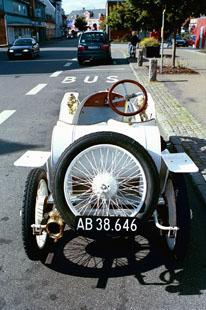 It is thought that it was while in Nielsen's ownership the car was remodelled and updated, this appears to have been entirely a cosmetic revision, a common practice in this period for a number of marques. For chassis 446, this work included the fitting of a shroud for the radiator increasing it to resemble a more modern Bugatti and similarly contemporary bodywork also.
It is thought that it was while in Nielsen's ownership the car was remodelled and updated, this appears to have been entirely a cosmetic revision, a common practice in this period for a number of marques. For chassis 446, this work included the fitting of a shroud for the radiator increasing it to resemble a more modern Bugatti and similarly contemporary bodywork also.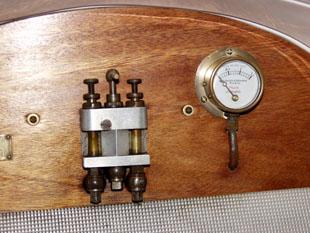
Condition
On inspection the Bugatti remains original and to correct factory specification. The car retains its original engine, number 88, which is stamped in various places on engine components. In addition the chassis, axles, gearbox, steering box are evidently all the original units, as are the water pump and oiling system, even the wheels are the correct 1912 pattern wires. The radiator is in remarkably good cosmetic order, though it has a slight weep and still wears its original manufacturer's plate reading 'Automobil Kuhler 'PATENT' Dr Zimmermann fabric Ludwigshafen \aa Rhein'.
Back to the Bugatti revue